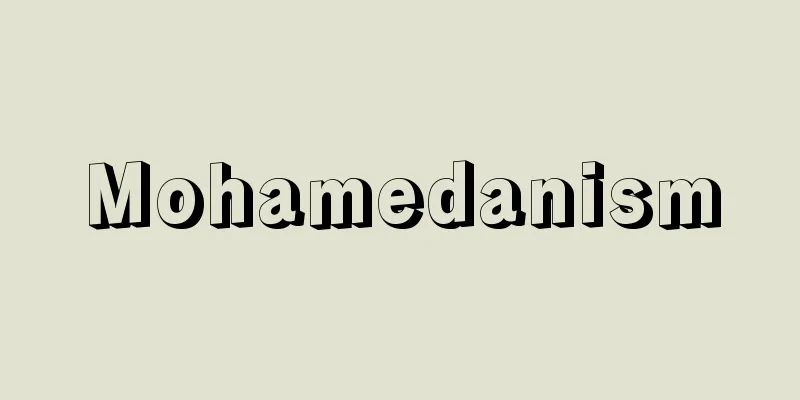Ikon (English spelling) German

|
Holy images. The English word is "icon" and the Russian word is "икона", both of which come from the Greek word "eikōn" meaning "image". They developed in the cultural sphere of the Eastern Church and belong to Byzantine art. They are images for worship that mainly depict images of Christ, the Virgin Mary, and saints. They are mainly made of tempera-painted panels, but they have also been produced as mosaics. Regarding the origin, there is the Shroud of the Holy Sepulchre, known as the "icon made without hands." This was born from the legend that when Christ ascended the hill of Golgotha, he wiped his face with a cloth, and his face was reproduced on the cloth. It is a simple design of Christ's face on a cloth. However, icon worship was not practiced in early Christianity, but it is said to have begun after the 2nd century and became popular around the 4th century. Later, from the 8th to 9th centuries, there was a battle to destroy icons (iconoclasm) among Byzantine priests. For this reason, the development of early icons has not yet been fully elucidated. However, some icons escaped the disaster because they were located in remote areas, and some icons thought to have been made around the 6th century still remain. In 843, icon worship was officially recognized again, and icons entered a new stage of development. Icons spread widely to areas where Greek Orthodoxy was being spread, including Asia Minor, Greece, Bulgaria, Serbia, Romania, and Russia. In addition, there was a large outflow of Byzantine art to Western Europe from the 9th century onwards, and the aesthetic world of icons had a strong influence on Italian art of the 13th century. For example, the direct influence of icons can be seen in Giotto's Madonna and Child. However, it was Russia that icons flourished the most, as Russia adopted Greek Orthodoxy as its state religion in the 10th century and used its authority to spread the religion, making full use of the religious power of icons. [Hiroshi Kimura] Russian IconsThe rapid spread of icon worship in Russia seems to have a subtle connection to the earlier pagan beliefs. That is, because the general public had been practicing a "dual faith" with paganism for a long time, the production of icons incorporating pagan elements made it easier for people to convert from paganism. The prevalence of icons in Russia was enormous, considering that in addition to the large icons and iconostases in churches (a structure in which rows of icons are lined up inside a church to form a wall separating the sanctuary from the seating area for ordinary believers), there were two or three icons in every believer's home (which means every home in Russia). These icons were closely linked to the religious life of Russians, and had a subtle but profound influence on the spiritual formation of Russians. Thus, icon production in Russia was actively carried out by the Novgorod School (12th to 14th centuries) and the Moscow School (from the 15th century onwards), but there is also a great deal to be seen in the work of the Vladimir School, Pskov School, etc. Of course, icons do not go beyond the scope of religious art and are ultimately objects of faith, but it is said that the reason Russians chose Greek Orthodoxy as their state religion was because they were impressed by its aesthetic rituals, and so it can be said that the aesthetic world of icons in the Russian Orthodox Church carries a considerable weight. In the history of Russian icons, three artists must be mentioned: Theophanes the Great (Greek Theophanes), who came to Novgorod from Constantinople (Istanbul) in the mid-14th century and trained many disciples; his disciple Andrei Rublev, who became the pinnacle of Russian icon painters; and Dionysius, who inherited Rublev's style and left behind new works in terms of color. Originally, icon production was often carried out in individual workshops, and there are few icons whose makers are known by name, but the icons of the above three artists are exceptional in that their outstanding aesthetic worlds have been passed down to the present day. Today, icons are often valued purely as works of art, detached from their religious nature. However, in Russia, icons began to be valued in this way only in the 20th century. The French painter Matisse once declared about Russian icons, "This is true folk art, and a source of artistic exploration," and the aesthetic world of icons is likely to continue to be reevaluated in the future. [Hiroshi Kimura] "The World of Icons" by Yasuko Hamada (1978, Bijutsu Shuppansha) [Reference] |Source: Shogakukan Encyclopedia Nipponica About Encyclopedia Nipponica Information | Legend |
|
聖画像。英語はicon、ロシア語はиконаで、ともに「形象」を意味するギリシア語のeikōnに由来する。東方教会の文化圏で発達したもので、ビザンティン美術に属し、主としてキリスト、聖母、聖者たちの像を描いた礼拝用の画像である。その素材はテンペラ技法による板絵が主流であるが、モザイクなどでも制作されたことがある。 起源については、いわゆる「人の手によらざるイコン」とよばれる聖骸(がい)布像がある。これは、ゴルゴタの丘を登るキリストが布で顔をぬぐったところ、その布の上に彼の顔が生き写しになったという伝説から生まれたもので、キリストの顔を布の上に描いた簡潔な図柄である。もっとも、初期キリスト教ではイコン崇拝は行われず、2世紀以降から始まって4世紀ごろに盛んになったといわれている。その後8世紀から9世紀にかけてビザンティンの神父たちの間ではイコン破壊の闘い(イコノクラスムiconoclasm)が起こっている。このため、初期イコンの発展状況についてはいまなお十分な解明が行われていない。しかし、秘境にあったために難を免れたイコンもあり、6世紀ごろの制作と考えられるものも現存する。 843年にふたたびイコン崇拝が公認され、イコンは新しい発展段階に入っていく。すなわち、ギリシア正教が布教されている土地、小アジア、ギリシア、ブルガリア、セルビア、ルーマニア、ロシアの各地へ広く伝播(でんぱ)した。また、9世紀以降西欧へのビザンティン美術の流出も多く、イコンの美的世界は13世紀のイタリア美術にも色濃く影響を与えている。たとえば、ジョットの聖母子像などにも、イコンの直接的影響を読み取ることができる。 しかし、なんといってもイコンがいちばん花開いた土地はロシアであった。ロシアは10世紀にギリシア正教を国教として受け入れ、上からの権力で布教に努めたが、その際イコンのもつ宗教的な力を十二分に活用したからである。 [木村 浩] ロシア・イコンロシアにおけるイコン崇拝が急速に広がった背景には、それ以前の異教信仰とも微妙な関係があるように思われる。すなわち、かなり長期にわたって一般民衆の間に異教との「二重信仰」が続いたために、異教の要素を摂取したイコンを制作することによって、異教からの改宗を容易にしたからである。 ロシアにおけるイコンの普及は、教会における大型イコンとイコノスタス(会堂の内部にイコンを何段にも並べて、内陣と一般信者の座る場所とを壁状に仕切ったもの)のほか、信者の家庭(ということは全ロシアの各家庭を意味する)にそれぞれのイコンが二つや三つは存在していたことを考えれば、たいへんな数であったといえるだろう。それらイコンはロシア人の信仰生活と密接に結び付いており、ロシア人の精神形成に微妙かつ深刻な影響を与えた。 こうしてロシアではイコン制作がノブゴロド派(12~14世紀)、モスクワ派(15世紀以降)などによって精力的に行われたが、このほかウラジーミル派、プスコフ派などの仕事にもみるべきものが少なくない。もちろん、イコンは宗教美術の枠を出るものではなく、あくまで信仰の対象であるが、ロシア人がギリシア正教を国教として選んだ背景には、その美的儀式への感動があったといわれており、ロシア正教会でのイコンの美的世界は、それなりに大きな比重をもっているといえよう。 ロシア・イコンの歴史では、14世紀中ごろにコンスタンティノープル(イスタンブール)からノブゴロドへ渡来し、多くの弟子を育てたフェオファン・グレッグ(ギリシア人テオファネス)、その弟子でロシア・イコン画家の頂点にたつアンドレイ・ルブリョフ、その作風を受け継ぎ、色彩のうえで新しい仕事を残したディオニーシーの3人を特記しなければならない。もともとイコンの制作は工房単位で行われることが多く、作者名が明らかなイコンは少ないが、上記3人のイコンは例外的にその傑出した美的世界を今日に伝えている。 今日、イコンはその宗教的性格を離れて、純粋に美術品として評価されることが多くなっている。しかし、ロシアにおいてもイコンをそのような目で評価しだしたのは20世紀になってからである。フランスの画家マチスはかつてロシア・イコンについて「これこそ真の民衆芸術であり、芸術探究の源泉である」と喝破したが、今後ともイコンの美的世界はますます再評価されていくであろう。 [木村 浩] 『浜田靖子著『イコンの世界』(1978・美術出版社)』 [参照項目] |出典 小学館 日本大百科全書(ニッポニカ)日本大百科全書(ニッポニカ)について 情報 | 凡例 |
Recommend
santouri (English spelling) santouri
…In Arabic, it was also called sanṭīr, but today ...
Act on the Punishment of Violence, etc.
This law (1926) aims to severely punish violent ac...
Teucrium japonicum Houtt.
A perennial plant of the Lamiaceae family (illustr...
biopsy
(1) Peripheral nerve biopsy ) The sural nerve is g...
Shoulder-hand syndrome
In addition to dull shoulder pain, movement is res...
Mashiko ware
Pottery kilns and their products in Mashiko Town,...
Great Buddha's Eye Opening Ceremony
A play written by Nagata Hideo. Five acts, twelve ...
Al Rafiqah - Al Rafiqah
…Its Greek name was Nikēphorion, and later it was...
Kasumi-tei (English) open levee
River levees are usually constructed continuously ...
Yahya Kemal
1884‐1958 Turkish poet. Born in Üsküp (now Skopje,...
Presidential system - Daitou ryosei (English spelling) Presidency
In a broad sense, it refers to a form of governme...
General birth rate - Ippanshūsseiritsu
...However, in reality, the denominator P does no...
Germination test - Hatsu-gashi-ken
It is to check the vitality of seeds (the proporti...
Macroeconomic variables - macroeconomic variables
…Similarly, GNP is an aggregate of the production...
Pack carburizing
...Steel made by carburizing is called case-harde...









